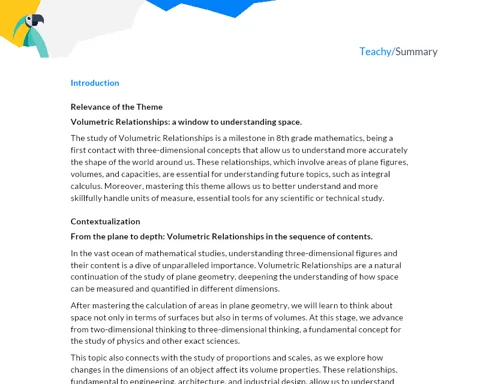Reflections of Plane Figures | Socioemotional Summary
Objectives
1. Understand the concept of reflection symmetry and its application in geometric figures.
2. Develop the ability to identify and draw reflected figures, especially triangles.
3. Connect mathematical learning to socio-emotional skills, such as self-awareness and responsible decision-making.
Contextualization
Have you ever thought about why butterfly wings look like mirrors of each other? Or why many iconic buildings have such a harmonious and balanced appearance? It's all thanks to reflection symmetry! 🌿 Architects, artists, and even nature use this concept to create beauty and proportion. Let's explore together how mathematics explains these fascinating phenomena and, at the same time, develop skills that go beyond formulas and calculations!
Important Topics
Definition of Reflection Symmetry
Reflection symmetry is a geometric property where a figure can be divided into two identical parts mirrored by an axis. Imagine looking into a mirror; everything on the left appears on the right, and vice versa. This magic of reflection applies to geometric figures, creating harmony and balance.
-
Axis of Symmetry: This is the line that divides the figure into two mirrored parts. It can be horizontal, vertical, or diagonal.
-
Identical Parts: The two halves of the figure are exactly the same, but inverted.
-
Preservation of Properties: The reflected figure maintains its measurements and shapes, but its orientation is mirrored.
Application in Plane Figures
We can apply reflection symmetry to various plane figures such as triangles, squares, and circles. This process helps to better understand geometry and also to develop spatial perception. Seeing reflected figures helps us view the world from another perspective, focusing on symmetry and balance.
-
Triangles: The reflection of a triangle across an axis creates an image that is a perfect mirror of the original.
-
Squares and Rectangles: These are easy to visualize because they have multiple axes of symmetry.
-
Circles: Although a circle may seem symmetrical in any direction, reflecting half of it across an axis still illustrates radial symmetry.
Properties of Reflections
When reflecting a figure, the resulting image retains the same dimensions and shapes, but its orientation is inverted. This property is fundamental for solving geometric problems and is the basis for many advanced concepts in mathematics and art.
-
Inversion of Orientation: The reflected figure is an inverted image (left/right, top/bottom) of the original.
-
Conservation of Measurements: All measurements, such as sides and angles, remain the same.
-
Applicability: This property is used in design, architecture, and many other fields to create visual symmetries.
Key Terms
-
Reflection Symmetry: A geometric property where a figure is divided into mirrored identical parts.
-
Axis of Symmetry: A line that divides the figure into two mirrored parts.
-
Reflected Figure: The inverse image of the original figure relative to the axis of symmetry.
To Reflect
-
How do you feel when working with symmetrical figures? Does it bring a sense of harmony and balance to you?
-
What emotional challenges have you encountered when drawing reflected figures? How did you deal with those feelings?
-
Think of a situation outside of school where symmetry is important. How can understanding reflection symmetry help you appreciate or solve problems in that situation?
Important Conclusions
-
Reflection symmetry is a fascinating geometric property where a figure can be divided into two identical mirrored parts.
-
We learned how to draw and identify reflected figures, especially triangles, across a given axis.
-
Connecting these mathematical concepts to socio-emotional skills is essential for developing abilities such as self-awareness and responsible decision-making.
Impact on Society
Reflection symmetry has a direct impact on many areas of our daily lives. In architecture, for example, it is used to create balanced and harmonious buildings. This same symmetry can be seen in famous artworks and in nature, such as in the wings of butterflies and leaves of trees, bringing beauty and balance to our surroundings. 📐🏛️ Moreover, understanding reflection symmetry helps us develop important skills like problem-solving and critical thinking. This not only improves our academic performance but also better prepares us to deal with everyday challenges. Understanding and applying symmetry can help develop an analytical and creative outlook, essential for innovation and creating effective solutions in any field of work. 🚀🧠
Dealing with Emotions
To practice the RULER method at home, I suggest the following exercise: Take a quiet moment during your day to reflect on the emotions you felt while learning about reflection symmetry. Acknowledge those emotions (for example, frustration or satisfaction) and try to understand what caused them (perhaps the difficulty of drawing the figure or the joy of seeing perfect symmetry). Accurately name those emotions and think about how you expressed them during the lesson. Finally, imagine how you can effectively regulate those emotions if you encounter similar situations in the future, such as asking peers or teachers for help and staying calm under pressure.
Study Tips
-
Practice drawing reflections on graph paper regularly. This will help improve your accuracy and visual understanding of reflection symmetry.
-
Watch online videos and tutorials that explain the concept of symmetry in different contexts, such as in nature, art, and architecture.
-
Form study groups with your peers to discuss and solve symmetry problems together. Collaboration can make learning more fun and effective.



